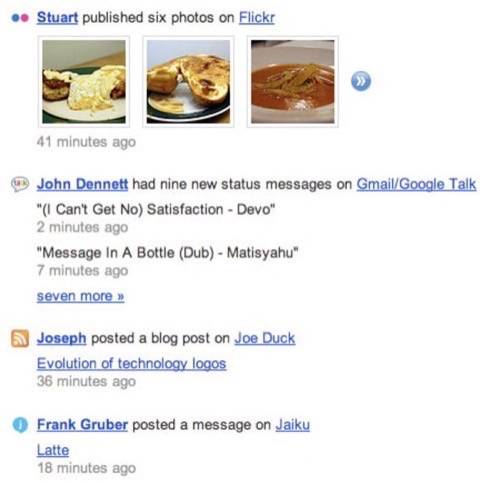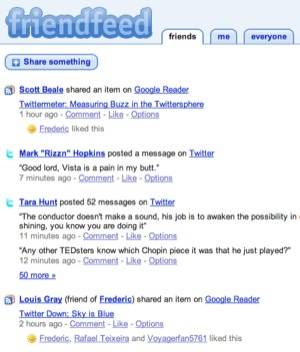Lifestream aggregator-turned-social network FriendFeed is the most hyped thing since sliced bread — or at least the most hyped web app since Twitter. Among the scads of lifestreaming apps, FriendFeed has garnered the lions share of recent press and hype among early adopters. The promise of lifestreaming is that it can bring all the various activity streams from the friends that you follow at multiple services under a single umbrella, vastly simplifying your information overloaded Internet existence. But do services like FriendFeed really solve the problem, or just highlight it? Can they even add to it?

We’ve definitely contributed to some of the hype around FriendFeed on this blog: we picked it as a potential breakout app at SXSW, and we backed it over a competing high profile lifestream app. But given the results so far to this week’s poll (you can vote below), there is clearly a big market for lifestream aggregators (64% of respondents say they use some sort of lifestreaming app).
Information Overload
But while FriendFeed and similar services bring activity streams into a single place, making it easier to keep track of your friend’s activity, there’s still an overwhelming amount of activity for most of us to track. I follow just a handful of people on Twitter, and already the stream of activity is fast and furious. The same applies to the activity of my hundreds of friends on Facebook. Add into that activity from tens of other accounts and you can imagine how quickly an aggregated feed of your friends’ activity can become overwhelming.

FriendFeed definitely does some things to alleviate the flow of information. For example, it groups similar items together — i.e., rather than sending the 50 Flickr images that you just uploaded or the 50 tweets you just made at Twitter to your stream individually, it sends one or two with a link to the rest. FriendFeed also added search yesterday, which is a very useful feature allowing people to see what their friends are doing around specific topics across multiple networks.
FriendFeed tracks 28 services. Profilactic, another lifestreaming application, supports 155. Robert Scoble asked yesterday, how many services do we need? Good question. While FriendFeed certainly makes it easier to track your friends activity at all those services, it also exposes you to all of them. Before if you wanted to follow Joe on Twitter and Facebook, you followed him on Twitter and Facebook. If you follow him on FriendFeed, you also follow Joe on Flickr, and Netflix, and Amazon, and MySpace, and Pownce, and Digg, and YouTube, and every other service he might use. Yikes! (Note: there are some third party hacks to get around this.)
Adding To The Problem
Generally, FriendFeed highlights the problem of information overload, but it also has a hand in contributing to it. We all thought we were signing up for a social activity aggregator, but BAM!, turns out FriendFeed is a social network in its own right. FriendFeed encourages people to comment on items sent through its feeds on FriendFeed rather than on the source site. Some people think this is a killer feature that focuses conversations around all of our activity, while others think that it fragments conversations and could lead to redundancy as a result of “Social Network Switching Decay.”
What it really might do is add to the noise. Lifestreaming services like FriendFeed that aggregate our social activity are supposed to be about making things simpler and lessening information overload — not about adding to the flow of information.
What We Need
In an attention economy information overload is a serious concern. Services that can aggregate activity streams — things that command a lot of our attention — and make sorting through all that information easier are welcome. FriendFeed has the potential to be a very useful service in this area, but it needs a few tweaks, in my opinion.

First, it needs filters. As Fred Oliveira wrote, “If I already have Twitteriffic on, It makes sense to be able to filter out all Twitter bits from my friendfeed. If Im in the mood for checking out photos from friends, I may want to see only photos on my friendfeed. If Im looking for what my friends have been listening to on Last.fm, I might want to see only that.”
Search was a good first step, but service and keyword based filters that give users more granular control over what sort of information is shown on their friends feed are a necessary next step. Filters could perhaps even be implemented on a friend-by-friend basis, and maybe automatic and weighted based on reading habits — similar to Facebook’s News Feed.
Filters would help us to actually reduce the amount of information we’re tracking and remove noise from our feeds.
Second, FriendFeed needs to be a read/write service. Not in the way it is now, but by letting users write to the services they’re pulling from. If I want to reply to a tweet, I don’t want to do it on FriendFeed, I want to do it at the source: Twitter. Allowing me to do so from within FriendFeed would be awesome.
Third, FriendFeed needs an API (supposedly this is coming). While you shouldn’t let your customers run your app, you should let your users define your application. Allowing developers to build on top of and extend the functionality of your application via mashups is often how good applications become killer applications. Without the ecosystem of awesome Twitter applications, for example, the service might not be nearly as fun to use and useful.
Conclusion
It is no wonder that FriendFeed has become the early breakout app of 2008. It has the potential to be truly useful, but right now it is doing more to highlight the problem of information overload — and even add to it — than it is to solve the problem. However, the promise of an application that can help us crawl out from under the constant stream of information that has inundated our lives is what makes FriendFeed, and similar services, so intriguing.
What do you think? Is FriendFeed a killer app as-is? Has it already helped your to cope with info overload? Let us know in the comments below, and be sure to vote in our poll.





















